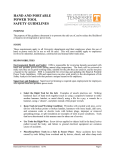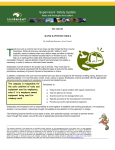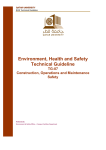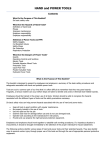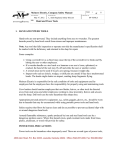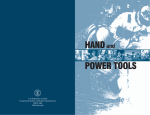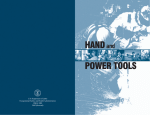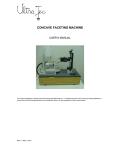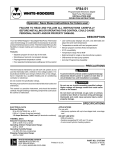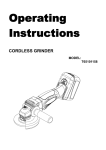Download Portable Power Tool Safety Program
Transcript
University of Nevada, Reno PORTABLE POWER TOOL SAFETY PROGRAM Program Contact Person: John A. Braun, CSP Environmental Health and Safety University of Nevada, Reno Phone: 775-784-6478 PORTABLE POWER TOOL SAFETY PROGRAM UNIVERSITY OF NEVADA, RENO TABLE OF CONTENTS 1.0 – INTRODUCTION 1.1 Policy 1.2 Purpose 1.3 Scope 2.0 – RESPONSIBILITY 2.1 Directors & Department Managers 2.2 Supervisor 2.3 Employees 2.4 Department of Environmental Health and Safety (EH&S) 3.0 – SWITCHES 4.0 – PORTABLE CIRCULAR SAWS 5.0 – PORTABLE BELT SANDING MACHINES 6.0 – COMPRESSED AIR TOOLS 6.1 General Tool Requirements 6.2 Contact with Compressed Air 6.3 Cleaning 6.4 Air Hose & Plastic Pipe 6.5 Design and Construction 6.6 Tool Use 6.7 Fastener Driving Tools 7.0 – POWER ACTUATED FASTENING SYSTEMS 7.1 Tool Operators 7.2 Personal Protective Equipment 7.3 Design & Construction 7.4 Labeling 7.5 Powder Loads 7.6 Tool Use 7.7 Fasteners 7.8 Inspection & Maintenance 7.9 Storage 8.0 – POWER LAWNMOWERS 8.1 Design & Construction 8.2 Rules 8.3 Labels 8.4 Before Starting 8.5 Use 8.6 Nonelectric Mowers 8.7 Walk-Behind Mowers 8.8 Ride-On Mowers 3 3 3 3 4 4 4 4 4 7 9 10 11 11 11 11 12 13 13 14 15 15 15 16 16 17 18 19 20 20 21 21 21 22 22 22 23 23 23 27/28/2008 9.0 – JACKS 9.1 Labeling 9.2 Before Use 9.3 Lifting the Load 9.4 Inspection & Maintenance 10.0 – PORTABLE TOOLS USING ABRASIVE WHEELS 10.1 Design & Construction 10.2 Guards 10.3 Guards- Specific Wheels 10.4 Side Handles 10.5 Abrasive Wheels 10.6 Mounting 10.7 Flanges 10.8 Flanges – Specific Wheels 10.9 Blotters 10.10 Center Punch Test 10.11 Ring Test 11.0 – ABRASIVE WHEEL ILLUSTRATIONS 11.1 Wheels 11.2 Flanges 12.0 – GLOSSARY 24 24 24 25 26 27 27 28 29 30 30 30 31 32 33 34 35 37 37 44 47 37/28/2008 PORTABLE POWER TOOL SAFETY PROGRAM 1.0 INTRODUCTION 1.1 Policy It is the policy of the University of Nevada, Reno (UNR) to ensure safe and healthy learning, research, work, entertainment and student living environments for faculty, staff, students and visitors. Implicit in this policy is a requirement to provide all individuals with pertinent information regarding Portable Power Tool Safety. 1.2 Purpose The Portable Power Tool Safety Program has been developed for University employees that operate portable power tools. This program will help ensure the health and safety of employees at the University of Nevada, Reno. 1.3 Scope University employees who operate or could operate portable power tools should be trained on the specific equipment. 47/28/2008 2.0 RESPONSIBILITIES 2.1 Directors and Department Managers Designate individuals who must participate in and who will be responsible for the preparation and implementation of the Portable Power Tool Safety Program. Provide administrative and financial support for this program within individual departments. Ensure the Portable Power Tool Safety Program is implemented and maintained within the department. 2.2 Supervisors Implement all aspects of this program, including documentation of the inspections and training. The supervisor has been designated this responsibility, as he/she is involved with employees on a more frequent basis. Conduct hazard assessments and ensure that employees are informed, trained, and provided with the appropriate training. Ensure new employee complete Portable Power Tool Safety Program orientation/training. 2.3 Employees Comply with this program and any further safety recommendations provided by supervisors and/or the Environmental Health & Safety Department regarding portable power tool safety. Conduct all assigned tasks in a safe manner including following required portable power tool safety procedures. Report any unsafe or unhealthy work conditions and job related injuries or illnesses to the supervisor immediately. Attend required training sessions regarding the Portable Power Tool Safety Program. 2.4 Department of Environmental Health and Safety (EH&S) Provide technical information and assist departments in implementing the Portable Power Tool Safety Program in their workplace. Assist in providing Portable Power Tool Safety Program instruction, as needed. Review and revise the Portable Power Tool Safety Program, as needed for compliance with applicable regulations. 57/28/2008 Conduct portable power tool safety assessments to determine if engineering and controls are needed, and how they should be implemented. Recommend appropriate engineering controls, administrative controls and personal protective equipment. 67/28/2008 3.0 HAND HELD POWER TOOLS SWITCHES Make sure hand-held portable power tools have safe switches (controls) Exemption: ¾ Concrete vibrators ¾ Concrete breakers ¾ Powered tampers ¾ Jack hammers ¾ Rock drills ¾ Garden appliances ¾ Household and kitchen appliances ¾ Personal care appliances ¾ Medical or dental equipment ¾ Fixed machinery Make sure switches are safe (1)Make sure the operating switch is located in a position that makes it difficult to accidentally operate the tool. (2)Use the correct operating switch. ¾ Make sure hand-held gasoline-powered chain saws have a constant pressure throttle control that will shut off power to the chain when the pressure is released. ¾ Use a constant pressure switch that will shut off the power when the switch is released to turn on or operate any hand-held power tool. Exemptions: Some tools can use a lock-on feature with the constant pressure switch if the lockon feature can be turned off with a single motion of the same finger(s) that turned it on. You can use a lock-on feature with these hand-held tools: ¾ ¾ ¾ ¾ Drills Tappers Fastener drivers Grinders using a wheel greater than 2 inches in diameter ¾ Disc sanders ¾ Belt sanders 77/28/2008 ¾ Reciprocating saws ¾ Saber, scroll and jig saws using a blade with a shank width greater than 1/4 inch ¾ Other similarly operating powered tools. Exemptions: You can use a positive “on-off” switch with these hand-held tools: Platen sanders Grinders using a wheel 2 inches or less in diameter Routers Planers Laminate trimmers Nibblers Shears NOTE: The shank width of saber, scroll and jig saw blades is measured at the narrowest point on the blade shank. 87/28/2008 4.0 PORTABLE CIRCULAR SAWS Make sure portable circular saws are safe to use (1) Use a constant pressure switch to turn on or operate any circular saw using a blade that has a diameter greater than 2 inches. (2) Remove cracked saws and saw blades from service. (3) Make sure power driven circular saws that have a blade diameter larger than 2 inches have guards above and below the base plate (shoe) as listed in Table 2, Portable circular saw guarding requirements. Upper Guard Covers the blade to the depth of the teeth, except for the minimum arc necessary to allow the base to tilt for bevel cuts. Lower Guard Covers the blade to the depth of the teeth, except for the minimum arc necessary to allow proper: • Retraction of the guard • Contact with the work. Automatically and instantly returns to the position covering the blade when the saw is withdrawn from contact with the work. Exemption: Guarding requirements in subsection (3) of this section don’t apply to saws used in the meat cutting industry to cut meat. 97/28/2008 5.0 PORTABLE BELT SANDING MACHINES Make sure portable belt sanding machines are safe You must guard portable belt sanding machines Nip points where the sanding belt runs onto a pulley The unused run of the sanding belt 107/28/2008 6.0 COMPRESSED AIR TOOLS Make sure compressed air and compressed air tools are used safely This section applies to portable, hand-held compressed air powered tools. It also applies to air hose and plastic pipe used to supply compressed air to these tools. 6.1 GENERAL TOOL REQUIREMENTS Follow the manufacturer’s instructions You must follow the manufacturer’s instructions for safe use of the tool. Prevent air tools from ejecting attachments You must make sure the tool can't accidentally eject an attachment. Note: A retainer is needed if the tool doesn’t have a positive method of keeping the attachment in the tool. 6.2 CONTACT WITH COMPRESSED AIR Protect employees from contact with compressed air You must make sure a tool nozzle or an air hose opening isn’t: Pointed at anyone Allowed to contact a person’s body. 6.3 CLEANING Make sure safeguards are used when cleaning with compressed air You must use the following when cleaning with compressed air: Air pressure that has been reduced to less than 30 p.s.i. static pressure at the nozzle Effective chip guarding 117/28/2008 Note: You may use air pressure greater than 30 p.s.i. if you use a nozzle with vents, holes, flaps or slots that will direct the air flow away from the tip of the nozzle and will reduce the air flow to less than 30 p.s.i if the nozzle becomes blocked. Effective chip guarding means any method or equipment that protects the eyes and skin of the cleaner and other workers from flying chips or particles. Examples include: ¾ A protective cone around the nozzle to protect the cleaner ¾ Barriers, baffles or screens to protect other workers. Note: Appropriate personal protective equipment (PPE) must to be worn when cleaning with compressed air. The use of compressed air to blow away dirt, chips, iron fillings, or sharp fragments is a dangerous practice. If the pressure is strong enough to remove these particles, it will be strong enough to blow them into your eyes, ears or nose, or even the skin. It is far safer to use a brush or vacuum cleaner. If you work with compressed air, or if you use it off the job, please remember the following points: Do not play practical jokes with compressed air - it can be fatal. Never use compressed air to clean clothing, hair or body. Never point the hose at anyone and always see that nearby workers are out of the line of air flow. When not actually using the air, point the hose downwards and to the side of the feet. If the hose comes apart - and only then - seize at some distance from the business end, block air by bending it, switch off and re-connect. Do not leave with air on at the near switch or valve but turn off at the main. When crossing passageways, either suspend hose or guard it with boards or runways. Use only sound strong hose with secure couplings and connections. Wear suitable protective equipment - glasses, face shields, etc. Remember normal work clothing is no protection against compressed air. Air hoses should be securely held to prevent whipping. 6.4 AIR HOSE AND PLASTIC PIPE Make sure air hose and plastic pipe supplying compressed air to portable air tools are safe (1) Make sure the air hose and hose connections are suitable for the: Air pressure Use 127/28/2008 (2) Make sure any plastic pipe used to supply compressed air for portable air tools has been specifically identified by the manufacturer as being suitable for compressed air use. Note: Existing unapproved pipe that is buried underground or enclosed in shatter-resistant material is acceptable only if it completely eliminates the hazards created by the brittle nature of the pipe. 6.5 TOOL DESIGN AND CONSTRUCTION Make sure air tools are adequately designed and constructed Exemption: This section doesn’t apply to: Tools specifically for medical or dental use Tools specifically for use in the food processing industry Tools mounted in stationary installations Air hoists Construction and mining tools such as paving breakers, diggers, tampers, and rock drills You must make sure portable, hand-held air tools meet the requirements of: – ANSI B186.1-1984, Safety Code for Portable Air Tools. OR – ANSI/ISANTA SNT-101-1993, Portable, Compressed-Air-Actuated, Fastener Driving Tools-Safety Requirements for. Note: There may be a statement on the tool or in the instruction manual indicating the tool meets the requirements of the appropriate ANSI standard. If in doubt, check with the manufacturer. 6.6 TOOL USE Use air tools safely Exemption: This section doesn’t apply to: Tools specifically for medical or dental use Tools specifically for use in the food processing industry 137/28/2008 Tools mounted in stationary installations Air hoists Construction and mining tools such as paving breakers, diggers, tampers, and rock drills. You must (1) Relieve the pressure in the air line before disconnecting a compressed air tool from the line or disconnecting a hose joint unless there is automatic valve closing protection at the joint being separated. (2) Disconnect the tool from the compressed air supply before repairs are done. (3) Make sure that eye protection is worn at all times by: The person operating the tool Other persons in the area where tools are being used. 6.7 FASTENER DRIVING TOOLS Make sure fastener driving air tools (nailers and staplers) are safe You must (1) Make sure any fastener driving air tool discharges all air in the tool when disconnected from the compressed air supply. (2) Make sure that all pneumatically driven nailers, staplers, and other similar equipment provided with automatic fastener feed have a safety device on the muzzle to prevent the tool from ejecting fasteners, unless the muzzle is in contact with the work surface. Note: Pneumatic nailers or staplers don’t need this safety device if: The overall weight of the fastening device doesn’t exceed the weight of 1-1/2 inches of standard 18-gauge wire. The normal maximum diameter tolerance for manufacturing standard 18-gauge wire is .045 inches. The operator and any other person within 12 feet of the point of operation wear approved eye protection. 147/28/2008 7.0 POWER ACTUATED FASTENING SYSTEMS YOUR RESPONSIBILITY: Make sure powder actuated fastening systems are used safely Important: This section applies to any powder actuated fastening system designed to use the expanding gases from a powder load to propel a stud, pin, fastener, or other object into hard structural material. Exemption: This section doesn’t apply to: Devices designed to attach objects to soft construction material such as wood, plaster, tar, and dry wallboard Stud welding equipment 7.1 TOOL OPERATORS - Must make sure tool operators are qualified You must Make sure tools are used only by qualified operators Make sure operators have been trained by an authorized instructor. Note: Authorized instructors have to meet the instructor qualifications of ANSI A10.3-1995, Safety Requirements for Powder-Actuated Fastening Systems. You must make sure all tool operators can: Understand the manufacturer’s instructions Clean the tool properly Recognize any visibly worn or damaged parts Identify power load levels Operate the tool correctly • Make sure tool operators have a valid qualified operator’s card in their possession when they are using the tool. 7.2 PERSONAL PROTECTIVE EQUIPMENT - Make sure employees are aware tools are in use and wear appropriate personal protective equipment (PPE) You must (1) Make sure eye or face protection is worn by: Tool operators 157/28/2008 Assistants Persons close to where the tool is being used. (2) Post signs where tools are being used and in adjacent areas where tool use could pose a hazard. Signs must: Be easily seen Be at least 8 x 10 inches (20 x 25 cm) Use letters in boldface type at least one inch (2.5 cm) high Read “POWDER ACTUATED TOOL IN USE" or similar wording. Note: Tool use could create a hazard in adjacent areas by allowing a fastener to penetrate one or more of the following: Wall Floor Other working surface. 7.3 TOOL DESIGN AND CONSTRUCTION - Make sure tools are adequately designed and constructed You must (1) Make sure the tool meets the design and construction requirements of the American National Standards Institute (ANSI) standard, ANSI A10.3-1995, Safety Requirements for PowderActuated Fastening Systems. Note: There may be a statement on the tool or in the instruction manual indicating the tool meets the requirements of the appropriate ANSI standard. If in doubt, check with the manufacturer. (2) Make sure each tool has: Operator instructions and a tool service manual Powder load and fastener chart Service tools and accessories. 7.4 LABELING - Make sure tools and containers are properly labeled You must (1) Make sure tools are properly labeled. • Make sure each tool has a readable, permanent label that shows the manufacturer’s: 167/28/2008 Model number Unique serial number • Make sure there is a durable warning label on each tool that: – Reads "WARNING - FOR USE ONLY BY QUALIFIED OPERATORS ACCORDING TO MANUFACTURER'S INSTRUCTION MANUAL" OR – Uses words with the same meaning. (2) Make sure the tool storage container has these labels: "POWER ACTUATED TOOL" on the outside of the container in an easily seen position "WARNING - POWDER ACTUATED TOOL TO BE USED ONLY BY A QUALIFIED OPERATOR AND KEPT UNDER LOCK AND KEY WHEN NOT IN USE" on the inside cover. 7.5 POWDER LOADS - Make sure powder loads and power levels are properly identified and use proper powder loads You must make sure powder loads and power levels are identified as specified in Table 3, Powder-Load Identification. Table 3 Powder-Load Identification Power Level Case Color Load Color 1 Brass Gray 2 Brass Brown 3 Brass Green 4 Brass Yellow 5 Brass Red 6 Brass Purple 7 Nickel Gray 8 Nickel Brown 9 Nickel Green 10 Nickel Yellow 11 Nickel Red 12 Nickel Purple NOTE: Power level 1 is the lowest and 12 is the highest level. 177/28/2008 7.6 USE PROPER POWDER LOADS You must use only a powder load that is: – Recommended by the tool manufacturer for the particular tool OR – One that provides the same level of safety and performance TOOL USE - Make sure the tool is appropriate to the job and make sure the operator uses the tool safely You must (1) Use the lowest velocity class of tool and load that will properly set the fastener. (2) Use the proper shield, fixture, adaptor, or accessory that is: Suitable for the job Recommended and supplied by the manufacturer. You must make sure the operator: Inspects the tool before using it, as recommended by the tool manufacturer Uses the tool according to the manufacturer’s instructions Keeps the tool unloaded until just before using it Unloads the tool at once if work is interrupted after the tool has been loaded Doesn’t leave a tool or powder load unattended where it would be available to an unauthorized person Never points a tool (loaded or unloaded) at any part of a person’s body. Note: A magazine or clip fed tool isn’t considered loaded until a powder load is actually in the ram (firing chamber). You must (1) Make sure tools aren’t used in an explosive or flammable atmosphere. (2) Do this if the tool misfires: Hold it firmly against the work surface for 30 seconds THEN Follow the instructions in the tool manufacturer’s instruction manual. Hold the tool perpendicular to the work surface when fastening to any material. 187/28/2008 Exemption: This doesn’t apply if the tool manufacturer recommends a different technique for a specific job. 7.7 FASTENERS - Use fasteners safely You must (1) Use fasteners: • Recommended by the tool manufacturer for the particular tool OR • Fasteners that provide the same level of safety and performance. (2) Keep the fastener from passing completely through the structural material by using a backing material when driving a fastener into any material that is any of the following: Easily penetrated Thin Of questionable resistance (3) Make sure the material is suitable for fastening. Don’t drive fasteners into very hard or brittle material such as: Cast iron Glazed tile Hardened steel Glass block Natural rock Hollow tile Most brick You must make sure positive alignment with an existing hole is maintained by using a guide or other means supplied or recommended by the tool manufacturer before driving a fastener into the hole. Helpful Tool: Center Punch Test A center punch test will help you determine if the material is suitable. You can find a copy of this form in the Resources section of this chapter. You must (1) Make sure fasteners aren’t driven into any spalled (chipped or crumbled) area. 197/28/2008 (2) Drive fasteners into concrete only if the fastener shank will penetrate no more than 1/3 the thickness of the concrete. (3) Make sure fasteners are driven at least: 1/2 inch (13 mm) from the edge of steel 3 inches (75 mm) from the unsupported edge of masonry material Exemption: This doesn’t apply if an application is specifically required or recommended by the tool manufacturer. 7.8 INSPECTION AND MAINTENANCE - Inspect and maintain tools properly You must • Make sure any tool that isn't in proper working condition is: Immediately removed from service Tagged Properly repaired as specified in the manufacturer’s instructions before being used again • Regularly service the tool and inspect it for worn or damaged parts at intervals recommended by the tool manufacturer. • Replace worn or damaged parts before the tool is used. This must be done: By a qualified person Using only parts supplied by the tool manufacturer • Keep a written record of inspection dates. 7.9 STORAGE - Make sure tools are stored properly You must (1) Make sure there is a container that can be locked for each tool. (2) Make sure tools and powder loads that aren’t being used are: Locked in a container Stored in a safe place Only available to authorized persons (3) Store all manuals, maintenance tools, and accessories in the tool container when they aren’t being used. 207/28/2008 8.0 POWER LAWNMOWER YOUR RESPONSIBILITY: Make sure power lawnmowers are used safely 8.1 DESIGN AND CONSTRUCTION Make sure equipment meets minimum design and construction requirements You must (1) Make sure equipment meets ANSI design and construction requirements. • Make sure power lawnmowers manufactured on or after August 1, 2003, meet the requirements of the appropriate ANSI standard: – ANSI B71.1-1998, American National Standard for Consumer Turf Care Equipment Walk-Behind Mowers and Ride-On Machines with Mowers – Safety Specifications OR – ANSI B71.4-1999, American National Standard for Commercial Turf Care Equipment - Safety Specifications. (2) Make sure noncommercial power lawnmowers manufactured before the effective date of this chapter meet the requirements in chapter 296-806 WAC, Machine safety. Note: There may be a statement on the tool or in the instruction manual indicating the tool meets the requirements of the appropriate ANSI standard. If in doubt, check with the manufacturer. WAC 296-807-16 8.2 RULES (1) Position, guard or shield all power-driven shafts, chains, belts, gears, friction drive components, nip and pinch points, and any exposed components hot enough to cause burns while: Starting Mounting Operating the machine (2) Have a shutoff device that: • Will stop the motor or engine AND • Has to be intentionally and manually activated before the motor or engine can be restarted. 217/28/2008 8.3 LABELS Make sure the equipment has the appropriate labels and decals You must (1) Make sure all positions of the operating controls are clearly identified. (2) Make sure warning and caution labels or decals on the mower are readable and replace them if necessary. 8.4 BEFORE STARTING Make sure the operator understands and follows instructions before starting the mower You must (1) Make sure the operator understands all instructions for operating the mower that are in the manufacturer’s instructions and on the machine. • Make sure the operator is thoroughly familiar with the controls and proper use of the mower before starting it. (2) Make sure the proper guards, plates, grass catcher or other safety devices are in place before starting the mower. 8.5 USE Use the equipment safely You must (1) Follow the manufacturer’s instructions for safe use of the equipment. (2) Keep people clear of discharge opening(s). (3) Keep people’s hands and feet clear of rotating parts. (4) Clear the area of objects such as rocks, toys, wire, bones, sticks, etc., which could be picked up and thrown by the blade and create a hazard for the operator or other persons. (5) Make sure the operator stops the engine before: Leaving the equipment Unclogging the grass discharge chute Cleaning the mower (6) Make sure the operator wears safety goggles or safety glasses with side shields when operating the mower. 227/28/2008 Note: Use the personal protective equipment (PPE) hazard assessment to determine the type of footwear and other PPE the employees need to wear. See WAC 296-800-160, PPE, in the Safety and Health Core Rules. 8.6 NONELECTRIC MOWERS Protect employees from fuel and exhaust Exemption: This section doesn’t apply to electric engines. You must (1) Make sure to: Keep the gas cap on whenever the engine is running. Shut off the engine before and during refueling. (2) Make sure not to refuel the machine indoors. (3) Make sure not to run the engine in a closed area. Exemption: You can refuel the machine indoors or run the engine in a closed area if the area was specifically designed for such use. 8.7 WALK-BEHIND MOWERS Use walk-behind mowers safely You must make sure the operator wears substantial footwear when operating a walk-behind mower. Note: Use the personal protective equipment (PPE) hazard assessment to determine the type of footwear and other PPE the employees need to wear. See WAC 296-800-160, PPE, in the Safety and Health Core Rules. You must mow across the face of a slope. 8.8 RIDE-ON MOWERS Use ride-on mowers safely You must (1) Make sure not to carry passengers. (2) Make sure the operator looks down and behind before and while moving backwards. 237/28/2008 9.0 JACKS Make sure jacks are safe to use Important: This section applies to portable hand- or power-operated: Hydraulic jacks Mechanical ratchet jacks Mechanical screw jacks 9.1 LABELS Make sure jacks are labeled with their rated load(s) You must • Make sure the rated load(s) of the jack is: Readable Durably marked in an easily seen location on the jack 9.2 BEFORE USE Make sure the jack is safe to lift the load You must (1) Visually examine the general condition of the jack before each use. Note: If a jack is to be used more than once on a shift, the visual examination is only required before the jack is used for the first time that shift. (2) Make sure the weight to be lifted or supported is within the rated load of the jack. (3) Make sure the base of the jack is on a firm foundation or blocked before lifting the load. (4) Make sure hydraulic jacks exposed to freezing temperatures function properly at the temperature they will be used. 247/28/2008 9.3 LIFTING THE LOAD Lift the load safely You must (1) Place a block between the load cap and the load if the load could slip off the jack. (2) Secure the load from falling or slipping immediately after it is raised by one or more of the following: Cribbing Blocking Some other equally effective method (3) Make sure you don’t exceed the limit of travel of the jack. Note: The limit of travel can be determined by one or more of the following: A positive stop A stop indicator Some other equally effective method 9.4 INSPECTION AND MAINTENANCE Visually inspect jacks and keep them in good working order Note: There are 2 types of inspection, frequent or periodic, depending on how often they are done. You must (1) Inspect jacks at appropriate intervals: • Make sure frequent inspections are done by the operator or other designated person as follows: Before a jack is first placed in service. Monthly for a jack used in normal service. Daily or before each use for a jack used for other than normal service. Before using a jack that has been altered, modified, or repaired. Before using a jack that hasn’t been used in one year or more. • Make sure a periodic inspection of the jack is done once a year. • Inspect the jack using Table 4, Jack Inspection Requirements, during any frequent or periodic inspection. 257/28/2008 (2) Make sure a jack that is out of order is: Tagged Not used until repaired (3) Make sure a jack is properly lubricated at regular intervals. Note: The jack should be lubricated following the manufacturer’s instructions. Table 4 Jack Inspection Requirements Inspection Item Frequent Inspection Check all of the following items that apply to the jack: - Improper pawl engagement - Excessive pawl wear - Chipped, cracked, or worn rack teeth - Cracked or damaged housing - Damaged, bent, or worn threads - Leaking hydraulic fluid - Scored or damaged plunger - Improper functioning - Free movement of swivel, heads, and caps - Loose bolts or rivets - Damaged or improperly assembled accessory equipment - Rack wear or bending - Other items as specified in the manufacturer’s instructions Watch the jack during operation More detailed inspection required if a designated person determines any condition discovered is a hazard Clean and check internal parts for wear or damage if inspection indicates an internal problem Periodic Inspection X X X X X X X X X X X X X X X X X X X X X X X X X X X X X X 267/28/2008 10.0 PORTABLE TOOLS USING ABRASIVE WHEELS Make sure abrasive wheel tools and wheels are safe to use Important: This section applies to portable tools using abrasive wheels. Definition: Abrasive wheel -A grinding tool consisting of bonded abrasive grains. This includes diamond and reinforced wheels. Exemption: This section doesn’t apply to machines using: Natural sandstone wheels Pulpstone wheels Coated abrasive products Loose abrasives 10.1 DESIGN AND CONSTRUCTION Make sure abrasive wheels and tools are properly designed and constructed You must • Make sure abrasive wheels and tools meet the design and construction requirements of: – American National Standards Institute (ANSI) B7.1-2000, Safety Requirements for the Use, Care and Protection of Abrasive Wheels OR – ANSI B186.1-1984, Safety Code for Portable Air Tools. Note: Tools may have a statement on the tool or in the instruction manual that the tool meets the appropriate ANSI standard. If in doubt, check with the manufacturer. Helpful Tool: Abrasive wheel illustrations You can find illustrations of specific types of wheels, general types of flanges, and mounting requirements, in the Resources section of this chapter. 6-807 277/28/2008 10.2 GUARDS Make sure machines have safety guards and Keep safety guards in good functional condition You must • Use abrasive wheels only on machines that have safety guards. • Make sure the safety guard: Is mounted so it maintains proper alignment with the wheel Is mounted with fasteners strong enough to keep the guard in position if a wheel breaks Is positioned to deflect pieces of an accidentally broken wheel away from the operator Covers the spindle end, nut, and flange projections. Exemption: Safety guards aren’t required on machines that use: Wheels for internal grinding while advancing, retracting or within the work Mounted wheels 2 inches or less in diameter Types 16, 17, 18, 18R, and 19 cones and plugs and threaded hole pot balls where: o The work offers protection Or o The size doesn’t exceed 3 inches in diameter by 5 inches long. Notched, segmented, or continuous rim metal centered diamond lapidary wheels that are: o Used with a coolant deflector And o Operated at 3,500 SFPM or less. WAC 296-807-180 Exemption: – Type 1 wheels that are: 2 inches or less in diameter 1/2 inch or less thick Operating at peripheral speeds less than 1,800 SFPM Mounted on mandrels and used in portable drills. 287/28/2008 – Type 1 reinforced wheels that are: 3 inches or less in diameter 1/4 inch or less thick Operating at peripheral speeds of 9,500 SFPM or less Used by operators wearing safety glasses and face shields. – Valve seating grinding wheels 10.3 GUARDS - SPECIFIC WHEELS Use specific safety guards for machines using Type 1 grinding wheels, cutting-off wheels, and tuck pointing wheels. Use specific safety guards for vertical and angle grinders using Type 6 or Type 11 wheels. Use specific safety guards for vertical and angle grinders using Type 27, 28 and 29 wheels. You must • Make sure the safety guard covers the top and sides of the wheel for at least 180°. Note: It isn’t required to cover the spindle end, nut and outer flange. You must • Make sure the safety guard: Covers the wheel’s plane of rotation toward the operator for at least 180° Covers the side of the wheel toward the driving flange for at least 180° Has a skirt which is adjustable to within 1/8 inch of the plane of the surface of the wheel • Make sure not to use a “revolving cup guard.” Note: “Cup back bushings” don’t substitute for safety guards. • Make sure safety guards: Cover the wheel’s plane of rotation toward the operator for at least 180° Cover the side of the wheel toward the driving flange for at least 180° x Have a lip on the outer edge that: • Extends beyond the surface of the wheel throughout the 180° coverage AND • Curls inward to deflect wheel fragments. 297/28/2008 10.4 SIDE HANDLES Use side handles on vertical and angle grinders You must • Use a side handle on all 4-inch and larger vertical and angle grinders. 10.5 ABRASIVE WHEELS - Make sure abrasive wheels are safe to use You must • Do the following before mounting a wheel: Visually inspect the wheel for cracks or damage Perform a ring test for cracks (size and shape of the wheel permitting) Make sure the spindle speed of the machine isn’t greater than the operating speed of the wheel. Make sure a damaged or cracked wheel isn’t mounted or used. Helpful Tool: Ring Test You can find illustrations on how to do a ring test in the Resources section of this chapter. 10.6 MOUNTING - Mount wheels properly You must (1) Make sure wheels fit freely on the spindle, wheel sleeves, or adaptors, and remain free under all grinding conditions. (2) Make sure wheel, blotter and flange surfaces that contact each other are flat and free of foreign particles. (3) Make sure any reducing bushing used in the wheel hole: Fits freely on the spindle and maintains proper clearance Doesn’t exceed the width of the wheel or contact the flanges. (4) Make sure that multiple wheels mounted between a single set of flanges are either: • Cemented together OR • Separated by spacers that have a diameter and bearing surface that is the same as the mounting flanges. 307/28/2008 10.7 FLANGES - Use proper flanges, Make sure flanges are in good condition You must mount all abrasive wheels between flanges that have a diameter at least 1/3 the diameter of the wheel. Exemption: This requirement doesn't apply to the following types of wheels: Mounted wheels Cup, cone or plug wheels with threaded inserts or projecting studs Abrasive disc wheels (inserted nut, inserted washer and projecting stud type) Plate mounted wheels Cylinder, cup, or segmental wheels mounted in chucks Types 27, 28 and 29 wheels Internal wheels less than 2 inches in diameter Modified Type 6 and 11 wheels (terrazzo) Types 1 and 27A cutting-off wheels. You must make sure flanges are: Dimensionally accurate Properly balanced Flat Free of rough surfaces or sharp edges. You must make sure, if a wheel is mounted between 2 flanges, that both flanges: Are the same diameter Have equal bearing surfaces Exemption: The following wheels don’t require same diameter, equal bearing surface flanges: Types 27, 28, and 29 wheels with adaptors Modified Types 6 and 11 wheels with tapered K dimension Internal wheels less than 2 inches in diameter You must make sure the driving flange is: – Part of the spindle OR – Securely fastened to the spindle. 317/28/2008 You must • Make sure flange bearing surfaces are in good condition. • Replace or re-machine any flange with a mounting surface that has any of the following problems: Warped Burred on the bearing surface Excessively worn (thickness or diameter) Out of true Note: Flanges that are refaced or trued need to satisfy minimum dimension requirements specified in ANSI B7.1-2000, Safety Requirements for the Use, Care and Protection of Abrasive Wheels. 10.8 FLANGES - SPECIFIC WHEELS - Use specific flanges for Type 1 cutting-off wheels. Use specific flanges for Type 27A cutting-off wheels. Use specific flanges for threaded hole wheels. Use specific flanges for cup, cone or plug wheels with threaded inserts or projecting studs You must • Mount Type 1 cutting-off wheels between flanges that are: Properly relieved with matching bearing surfaces At least 1/4 the wheel diameter Note: American National Standards Institute (ANSI) B7.1-2000, Safety Requirements for the Use, Care and Protection of Abrasive Wheels, has specific exemptions for some reinforced, bonded abrasive cutting-off wheels and steel centered, diamond cutting-off wheels. These You must • Mount Type 27A cutting-off wheels between flanges that are: Flat (unrelieved) with matching bearing surfaces At least 1/4 the wheel diameter You must • Use a back flange to mount threaded hole wheels that is: Flat (unrelieved) Securely fastened and square to the spindle axis Able to properly support the wheel 327/28/2008 You must mount cup, cone or plug wheels with threaded inserts or projecting studs against a straight, unrelieved flange. 10.9 BLOTTERS - Use blotters when required You must • Use a blotter between each flange and the abrasive wheel surface to uniformly distribute flange pressure. • Make sure the blotter covers the entire flange contact area. • Use a new blotter each time a wheel is mounted unless the wheel has a blotter already attached to it by the manufacturer. • Make sure scuffed or damaged blotters aren’t used. Exemption: You don’t need to use a blotter with: Mounted wheels Abrasive disc and Type 2 wheels which are mounted by inserted nuts, inserted washers, or projecting studs Plate mounted wheels Wheels mounted in chucks (such as cylinders and segmental wheels) Types 27, 28 and 29 wheels Type 1 and Type 27A cutting-off wheels Internal wheels less than 2 inches in diameter Diamond and cubic boron nitride wheels with metal or carbon fiber cores. BLOTTERS - TYPE 6 AND 11 WHEELS - Meet specific blotter requirements when using modified Types 6 and 11 wheels (terrazzo) You must mount modified Types 6 and 11 wheels (terrazzo) with a blotter applied to the flat side of the wheel only. 337/28/2008 10.10 CENTER PUNCH TEST Do a center punch test with a hammer to determine the suitability of the base material for a powder actuated fastening. This test is relatively simple and can help you do a safe, successful fastening. Be sure to wear the appropriate eye protection when performing this test. The test is done as follows: (1) Select the fastener to be used for the job. (2) Place the point of the fastener against the base material. (3) Strike the fastener with a single hammer blow, then examine the point. If the point of the fastener is not blunted and the base material has a clear point indentation, you can do the first test installation. Use of a powder actuated fastening system is not recommended if the following occurs during the center punch test: • The fastener point has been blunted. This indicates that the base material is too hard. • The base material cracks or shatters. This indicates that the base material is too brittle. • When using an average hammer blow, the fastener penetrates the base material easily. 347/28/2008 This indicates that the base material is too soft. 10.11 RING TEST A ring test should be performed before mounting an abrasive wheel. This test is simple and can help determine if the wheel is cracked. Limitations: The wheel has to be dry and free of sawdust when applying the ring test, otherwise the sound may be deadened. The ring test doesn’t work with certain wheels because of their shape or size. Examples include: • Wheels 4 inches diameter and smaller • Plugs and Cones • Mounted Wheels • Segments • Plate-Mounted Wheels • Inserted Nut and Projecting Stud Disc Wheels How to do the test: (1) Suspend the wheel by putting a small pin or your finger through the arbor hole in the wheel. Heavier wheels may be allowed to rest in a vertical position on a clean hard floor (See Illustration 1). (2) Tap the flat side of the wheel with a light non-metallic implement, such as the handle of a screw driver, at a point • 45 degrees from the vertical center line on each side of the wheel (See Illustration 2) and • 1 – 2 inches from the edge of the wheel. Large, thick wheels may be struck on the periphery rather than the side of the wheel. (3) Rotate the wheel 45 degrees and repeat the test until the entire wheel has been checked. How to use the results: 357/28/2008 The ring test depends on the fact that a crack in the wheel will normally change the sound emitted when the wheel is lightly tapped. An undamaged wheel will give a clear tone. If cracked, there will be a dead sound and not a clear ring. Comparison of the sound with other wheels of the same lot and specification will allow rejection of any wheel with a suspiciously different ring. s Using Abrasive Wheels 367/28/2008 11.0 ABRASIVE WHEEL ILLUSTRATIONS 11.1 ABRASIVE WHEEL ILLUSTRATIONS - WHEELS This tool contains illustrations of: • Some specific types of wheels used in this chapter • General types of flanges used with abrasive wheels • Mounting of some specific types of wheels Information about the wheel type includes a definition and may have notes concerning wheel use or limitations. Information about mounting wheels lists only the mounting requirements. You will find these illustrations in this tool: Type 1 Wheel Type 6 Wheel Type 11 Wheel Type 27 and 27A Wheels Type 28 Wheel Type 29 Wheel Modified Type 6 and 11 Wheels (Terrazzo) Mounted Wheels Cone and Plug Wheels General Types of Flanges Mounting Type 27A Cutting-off Wheels Mounting Threaded Hole Wheels 377/28/2008 ABRASIVE WHEEL ILLUSTRATIONS - WHEELS Type 1 wheel An abrasive wheel shaped like a disc with a mounting hole in the middle. Sometimes called a “straight wheel.” It has diameter (D), thickness (T), and hole size (H) dimensions. Grinding is normally done on the periphery (outside curve) of the wheel (T dimension). Type 6 wheel An abrasive wheel shaped like a straight-sided cup or bowl with a mounting hole in the bottom of the cup. Sometimes called a “cup wheel.” It has diameter (D), thickness (T), hole size (H), rim thickness (W), and back thickness (E) dimensions. Grinding is normally done on the cup rim (W dimension). 387/28/2008 ABRASIVE WHEEL ILLUSTRATIONS - WHEELS Type 11 wheel An abrasive wheel shaped like a cup or bowl with a mounting hole in the bottom of the cup. The sides of the cup are not straight-sided but are angled outward. Sometimes called a “flaring cup wheel” since the sides are “flared” out. It has double diameter dimensions (top D and bottom J). It also has thickness (T), hole size (H), rim thickness (W) and back thickness (E) dimensions. Grinding is normally done on the cup rim (W dimension). 397/28/2008 ABRASIVE WHEEL ILLUSTRATIONS – WHEELS Type 27 wheel An abrasive wheel similar to a Type 1 wheel, but the center of the wheel around the mounting hole is pushed back (depressed). Sometimes called a “depressed center” wheel. It has diameter (D), thickness (U) and hole size (H) dimensions. The depressed center allows grinding on the flat surface of the wheel without Interference from the flange or mounting hardware. Type 27A cutting-off wheel Similar to a Type 27 wheel. Specifically designed for use on cutting-off machines. Note: ¾ Type 27 wheels are manufactured with flat grinding rims or faces and are designed for: o Side grinding when held at a slight angle to the workpiece o Peripheral grinding, including small cutting-off and shallow notching operations ¾ Type 27 wheels may be used flat when grinding masonry and concrete surfaces such as ceilings and walls. 407/28/2008 ABRASIVE WHEEL ILLUSTRATIONS – WHEELS Type 28 wheel An abrasive wheel similar to a Type 27 wheel, but the face of the wheel is angled upward and away from the mounting hole. The face of a Type 27 wheel is flat and perpendicular to the mounting hole. A Type 28 wheel is also called a “depressed center” wheel. It has diameter (D), thickness (U) and hole size (H) dimensions. The depressed center allow grinding without interference from the mounting. A Type 28 wheel has a saucer-shaped grinding rim and is designed for corner grinding and side grinding. Type 29 wheel An abrasive wheel that has reversed, saucer-shaped grinding rims (similar to a partially opened umbrella). 417/28/2008 ABRASIVE WHEEL ILLUSTRATIONS – WHEELS Modified Type 6 and 11 wheels (Terrazzo) Similar to Type 6 “straight cup” wheels and Type 11 “flaring cup” wheels except for the bottom of the cup. The bottom of the cup is flat in Type 6 and 11 wheels. The modified wheels have bottoms that are sloped downwards towards the mounting hole. These modified wheels need to be mounted using a special tapered flange furnished by the tool manufacturer. These wheels are used in the terrazzo trade. 427/28/2008 ABRASIVE WHEEL ILLUSTRATIONS - WHEELS Mounted wheels Bonded abrasive wheels of various shapes, usually 2 inches diameter or smaller, that are secured to plain or threaded steel mandrels. Cone and plug wheels (Types 16, 17, 18, 18R, and 19) Abrasive wheels manufactured with blind hole threaded bushings. They may be used on all surfaces except the flat mounting surface (D). Specific characteristics of the different cone and plug wheels are: • Type 16 cone wheels have a curved side with a nose radius • Type 17 cone wheels have straight sides with or without a nose radius • Type 18 and 18R plug wheels are cylindrical in shape with either a square or curved grinding end • Type 19 cone wheels are a combination of cone and plug shapes 437/28/2008 11.2 ABRASIVE WHEEL ILLUSTRATIONS - FLANGES Flanges Collars, discs or plates between or against which wheels are mounted. There are four types of flanges: • Adaptor • Sleeve adaptor • Straight relieved • Straight unrelieved STRAIGHT UNRELIEVED FLANGE 447/28/2008 ABRASIVE WHEEL ILLUSTRATIONS - FLANGES Mounting Type 27A cutting-off wheels Type 27A cutting-off wheels are mounted between flanges that are: • Flat (unrelieved) with matching bearing surfaces and • At least 1/4 the wheel diameter 457/28/2008 ABRASIVE WHEEL ILLUSTRATIONS - WHEELS Mounting threaded hole wheels Threaded hole wheels are mounted against a back flange that is: • Flat (unrelieved) • Securely fastened and square to the spindle axis • Able to properly support the wheel 467/28/2008 12.0 GLOSSARY Abrasive wheel - A grinding tool consisting of bonded abrasive grains. This includes diamond and reinforced wheels. Blind hole - A hole drilled in an object, such as an abrasive wheel, that doesn’t go all the way through. Blotter - A compressible disc or washer, usually of blotting paper, plastic, cardboard, or gasket material, that is used between the wheel and the flanges to evenly distribute flange pressure on the wheel. Cone and plug wheels (Types 16, 17, 18, 18R, and 19) - Abrasive wheels manufactured with blind hole threaded bushings. They may be used on all surfaces except the flat mounting surface (D). Specific characteristics of the different cone and plug wheels are: – Type 16 cones have a curved side with a nose radius – Type 17 cones have straight sides with or without a nose radius – Type 18 and 18R plug wheels are cylindrical in shape with either a square or curved grinding end – Type 19 cone wheels are a combination of cone and plug shapes Cutting-off wheels - Abrasive wheels used to cut material such as masonry, pipe, etc. Designated person - A person selected or assigned by the employer or the employer’s representative as competent to perform specific duties. Discharge opening - An opening in a mower housing for discharging grass. Flanges - Collars, discs or plates between or against which wheels are mounted. There are 4 types of flanges: – Adaptor – Sleeve – Straight relieved – Straight unrelieved Grass catcher - Parts or a combination of parts to collect grass clippings or debris. Guard (abrasive wheels) - An enclosure designed to restrain the pieces of an abrasive wheel and furnish protection to the operator if the wheel is broken during operation. Guard - A part or assembly to prevent accidental contact with hazardous machine parts or to protect persons from other hazards created by the machinery. Inorganic bonded wheel - Abrasive wheels that are bonded by means of inorganic material such as clay, glass, porcelain, sodium silicate, magnesium oxychloride, or metal. 477/28/2008 Jack - A portable hand- or power-operated mechanism for lifting, lowering or moving horizontally a load by applying a pushing force. Modified Types 6 and 11 wheels (terrazzo) - Similar to Type 6 “straight cup” wheels and Type 11 “flaring cup” wheels except for the bottom of the cup. The bottom of the cup is flat in Type 6 and 11 wheels. The modified wheels have bottoms that are sloped downwards towards the mounting hole. These modified wheels need to be mounted using a special tapered flange furnished by the tool manufacturer. These wheels are used in the terrazzo trade. Mounted wheels - Bonded abrasive wheels of various shapes, usually 2 inches diameter or smaller, that are secured to plain or threaded steel mandrels. Normal service (jacks) - Raising or lowering axial loads that are 85% or less of the rated load under controlled conditions. Organic bonded wheels - Abrasive wheels that are bonded by means of organic material such as resin, rubber, shellac, or other similar bonding agent. Rated load - The maximum load that the jack is designed to lift or support. Reinforced wheels - Organic bonded abrasive wheels which have webbing, fabric or filament to provide resistance to complete breaking of the wheel should it become cracked or damaged. Terrazzo - A material of stone chips, such as marble, set in mortar and polished. Threaded hole wheels - Abrasive wheels that have one central threaded bushing, securely anchored in place. They are mounted by being screwed onto a threaded machine spindle so that the wheel back seats firmly against an unrelieved flat back flange. Tuck pointing wheels - Tuck pointing abrasive wheels are Type 1 reinforced, organic bonded wheels and have diameter, thickness and hole size dimensions. They are used to remove cement, mortar, or other nonmetallic jointing material. Type 1 wheel - An abrasive wheel shaped like a disc with a mounting hole in the middle. Sometimes called a “straight wheel.” It has diameter (D), thickness (T), and hole size (H) dimensions. Grinding is normally done on the periphery (outside curve) of the wheel (T dimension). Can be used for grinding, cutting-off, and tuck pointing. Type 2 wheel - An abrasive wheel shaped like an open-ended, hollow cylinder. Sometimes called a cylinder wheel. It has diameter (measured from the outer wall of the cylinder), wheel thickness (height of the cylinder), and rim thickness (thickness of the cylinder wall). Grinding is done on the end of the cylinder (rim thickness dimension). Type 6 wheel - An abrasive wheel shaped like a straight-sided cup or bowl with a mounting hole in the bottom of the cup. Sometimes called a “cup wheel.” It has diameter (D), thickness (T), 487/28/2008 hole size (H), rim thickness (W), and back thickness (E) dimensions. Grinding is normally done on the cup rim (W dimension). Type 11 wheel - An abrasive wheel shaped like a cup or bowl with a mounting hole in the bottom of the cup. The sides of the cup aren’t straight-sided but are angled outward. Sometimes called a “flaring cup wheel” since the sides are “flared” out. It has double diameter dimensions (top D and bottom J). It also has thickness (T), hole size (H), rim thickness (W) and back thickness (E) dimensions. Grinding is normally done on the cup rim (W dimension). Type 16, 17, 18, 18R, and 19 wheels - See cone and plug wheels. Type 27 wheel - An abrasive wheel similar to a Type 1 wheel, but the center of the wheel around the mounting hole is pushed back (depressed). Sometimes called a “depressed center” wheel. It has diameter (D), thickness (U) and hole size (H) dimensions. The depressed center allows grinding on the flat surface of the wheel without interference from the flange or mounting hardware. Type 27A cutting-off wheel - Similar to a Type 27 wheel. Specifically designed for use on cutting-off machines. Type 28 wheel – An abrasive wheel similar to a Type 27 wheel, but the face of the wheel is angled upward and away from the mounting hole. The face of a Type 27 wheel is flat and perpendicular to the mounting hole. A Type 28 wheel is also called a “depressed center” wheel. It has diameter (D), thickness (U) and hole size (H) dimensions. The depressed center allows grinding without interference from the mounting. A Type 28 wheel has a saucer-shaped grinding rim and is designed for corner grinding and side grinding. Type 29 wheel - An abrasive wheel that has reversed, saucer-shaped grinding rims (similar to a partially opened umbrella). 497/28/2008


















































